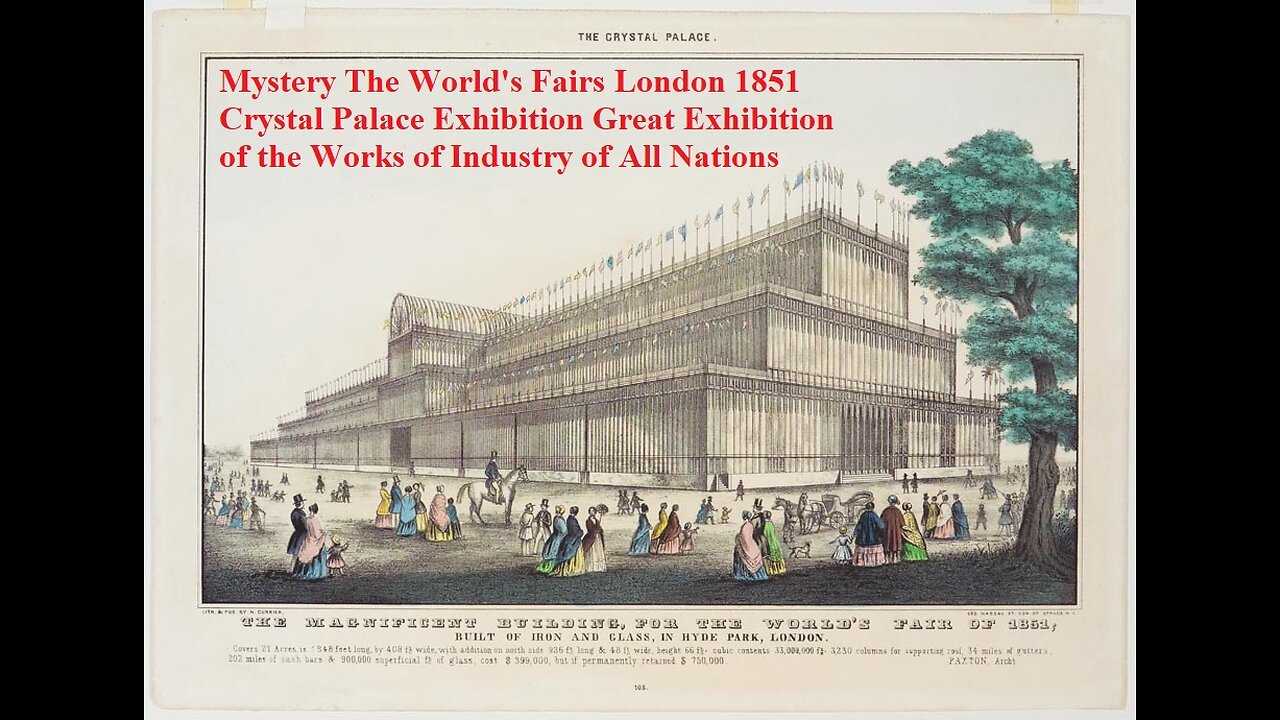Premium Only Content

Mystery The World's Fairs London 1851 Crystal Palace Works Industry All Nations
Mystery The World's Fairs Maybe the History we've been told is a lie! Were some ancient buildings built by a different race and their true history was covered up? Did ancient peoples have advanced forms of technology that have now been forgotten ? Was the massive kingdom of Tartaria visible on ancient maps much more advanced than we realize? This sub is an open forum for collaborative discussion of all topics "Tartaria" related, including Mud Flood, Tesla, AntiquiTech, Free Energy, Conspiracies, Hidden History, etc.
I wonder if this video has been posted here before? If yes, then i am not sorry for posting it again, because its just one helluva epic video. If not, I highly recommend watching it if you are interested in perhaps how Tartarian technology worked. I am still thinking about all the stuff he said and points out to us. As its a lot to deal with and can shake one up. I find it fascinating though.
Could it be that this civilization, split off from our official historical line of development, is behind many of the events of the 20th century?
And what of the World's Fairs? Were a large proportion of the World's Fair Buildings actually built from scratch, as the official historiography claims? There is much to suggest that the robber barons of the industrial age not only hid once widespread technological knowledge from us, but that they also hijacked some of the impressive architectural masterpieces in which parts of this knowledge was displayed.
Some of the buildings from the World's Fairs still exist today, and they are obviously not made of plaster or similar fragile materials. Were they subsequently rebuilt to be permanent structures? Is it even possible that the elaborately designed Expo sites were built with the technological capabilities of the time within just a few months, only to be destroyed again a few months later after the exhibitions had ended? Or is it plausible that after a great catastrophe the worldwide remains of the preceding high culture were not only systematically destroyed, but also pressed into an image of history imposed on us?
Some available information suggests that even after the worldwide, game-changing event we call the Reset or Mud Flood, there still remained countless complete and beautiful cities that were conquered by a new power elite and then repurposed as "World's Fairs".
Especially in America, the so-called New World, the many Greco-Roman cities would have been difficult to explain because in contrast to Europe, the Americas do not have an official greco-roman history.
The more carefully one investigates, the more difficult it becomes to find plausible explanations for the construction and destruction of these extraordinary and huge exhibition areas.
The official version about the World's Fairs can be summarized as follows: People in the 19th century loved Greco-Roman architecture for reasons unknown, so it was extremely important to the architects who organized the World's Fairs between 1850 and about 1914 to build in a classical style.
(Note: With World War I, classical architectural ambitions in Europe ended abruptly and many exhibitions also did not take place as planned. It was only in the wake of fascism that there was a return to ancient design principles, but these were often implemented superficially and were mainly applied to a few representative magnificent buildings. After the Second World War, on the other hand, classical architecture was deliberately replaced with new trends - e.g. Bauhaus and Brutalism. Officially the intention was to create an aesthetic distance to fascism, but in all likelihood its purpose was to cut the connection to the Old World through soulless, brutalistic architecture.)
No effort was spared for the world's fairs, enormous amounts of work went into creating complex statues, ornaments, columns, parks, buildings, and even the world's largest organs. No expenses were spared in the making of these massive structures. Made of plaster and linen or hemp fibers, they were only intended to last for the duration of the Expo. However the attention to detail was so great that purely visually there seemed to be no difference between the Expo buildings and the classical splendor-buildings of antiquity. The purpose of the World's Fairs was to make the supposedly "new" technologies discovered during the Industrial Revolution palatable to the masses, to create new markets. In the end, most of the buildings were torn down, with only meadows or empty parks remaining.
Great Exhibition London, Great Britain, 1851
The London "Crystal Palace Exhibition" was the first prominent worldwide industrial exhibition. A whole 28 countries with a total of 17,062 exhibitors on a total area of over 80,000 square meters took part and received about six million visitors in six months, a quantity comparable to about one third of the total population of Great Britain at that time. To appreciate the full scale, it is necessary to imagine that the gigantic glass house, fitted with cast-iron frame elements, was estimated to be three times the size of St Paul's Cathedral or four times the size of St Peter's Basilica.
In total, it is said, 4,000 tons of iron were processed for columns, trellis girders and gutters and about 153,000 square meters of glass were produced. 80 glaziers are said to have installed 18,000 panes in one week and more than 5,000 workers are said to have been employed on the building during the construction phase.
A civil engineer remarked about the Crystal Palace: Add to this the fact that simple automation processes for the mass production of glass did not develop until 30 years later. So everything had to be produced by hand, and the distance from the glassworks in Smethwick to Hyde Park, where the Crystal Palace was originally built, was around 209 km. And as if all this wasn't fantastic enough, the glass palace was completely dismantled after the exhibition, and then re-built in a larger form in Sydenham Hill and used as a museum there.
To bring visitors to the London exhibition site, two stations were newly built, both confusingly called "Crystal Palace" and differing only in their underground and overground locations respectively. The fire that destroyed the Crystal Palace in 1936 made the "High Level Station" virtually redundant, which is why it was eventually demolished. The beautifully tiled subway, supposedly built by Italian masons and stonemasons, however, survived.
Incidentally, parliamentary buildings made of wood and plaster were erected especially for the "Festival of the Empire", which was one of the largest single events at London's Crystal Palace and took place on 12 May 1911. These buildings were also intended to be used only temporarily and were connected by an electric tramway, the so-called "All-Red Route". For example, the replica of the Canadian and New Zealand Parliament Buildings, the former visible on the left in the foreground of the Crystal Palace. On November 30, 1936, however, the Crystal Palace fell victim to a devastating major fire.
The fire burned with great intensity all night, even 20 hours later there were reportedly still pockets of fire. The British press considered the destruction of the Crystal Palace a serious blow to the political power of England, and the public wondered "how steel and glass can burn so fiercely".
It is important to know that in glass production the raw materials are heated to about 1,600 to 1,800 °C, but finished glass can melt between 600 and 800 °C. The melting point of cast iron is relatively low when compared to other alloys. Cast iron, when compared with other alloys, has a relatively low melting point of around 1150°C. But the question is where the temperatures should have come from and whether furnishings would already have been sufficient to generate heat of this magnitude.
Incidentally, there has never been an official investigation into this incident, and the fire is still considered unsolved to this day.
LONDON, ENGLAND 1851
The Great Exhibition of the Arts & Industries of All Nations
Dates Open - May 1 to October 11, 1851. No Sunday openings. Was also open Monday and Tuesday, October 13-14 to exhibitors with the Closing Ceremony on October 15.
Attendance - Total paid and season ticket admissions, 6,039,195.
International Participants - 50 nations and 39 colonies/protectorates.
Total Cost - 335,742 pounds ($1,678,710)
Site Acreage - Entire site within Hyde Park covered 26 acres. The Great Exhibition building sat on 19 acres within the entire site.
Sanction - Prior to the Bureau of International Exhibitions. Although often called a Universal Exhibition due to its broad scope, it would not be considered a Universal style exhibition in the 21st century due to its size. The exhibition was organized by a Royal Commission with Prince Albert playing a central role. The government supported the idea in principal, but not financially.
Ticket Cost - Adult admission prices ranged from 1 shilling (25 cents) to 5 shillings ($1.25) to 2 shillings and 6d (63 cents) to 1 pound ($5.00), depending on the day. The average daily price was 59 cents.
Exhibitions were part of the landscape in continential Europe as well as the English isles from the beginning of the late 1800s with the Society of Art hosting annual exhibitions from 1845 forward. When the idea of hosting the next in the series of national exhibition for 1851 was brought forward, the idea of turning it into an international event was broached. This idea was not a new one, as other events had both solicited foreign contributions, i.e. Birmingham 1849, only to receive none, and the French national exhibition in the same year desired to be international, but the idea did not go over well with French manufacturers who did not want to compete against foreign products. On June 30, 1849, Prince Albert met with several colleagues, including Henry Cole, who had recently visited the Paris national exhibition and their idea, although turned down, of making in an international event. Prince Albert concurred and the committee agreed on six goals.
1) ... that the exhibit would have four divisions, (raw materials, machinery, manufactured products, and sculpture and plastic art generally.)
2) ... that it would be held in a temporary building in Hyde Park.
3) ...that the scope would be International.
4) ...that substantial prizes should be offered.
5) ...that a Royal Commission, with Prince Albert at its head, should carry out the plans.
6) ... and that funds would be raised by voluntary subscriptions and collected by the Royal Society of Arts.
On January 3, 1850, a Royal Commission was granted charter by the Government, taking over responsibilily from the Society of Arts. A subscription fund was launched on January 25, with the first list headed by the Queen and Prince Albert. By end of February, 70,000 pounds were subscripted, but more donations came in slowly. After that hesitant beginning, the guarantee fund rose to 350,000 pounds. The site problem was overcome by the approval of Hyde Park. And Joseph Paxton solved a third problem, of a temporary building of sufficient scope, by proposing the glass and iron Crystal Palace, which required only 17 weeks to erect building.
Inside the huge nineteen acre construction, half of the gallery exhibit space was taken by British goods and the remaining space, foreign. More than 40 different countries and their possessions were represented, including France, the most prominent.
The opening ceremonies were held on May 1 with Queen Victoria and her husband, Prince Albert, present and pleased. Attendance of over 6 million traipsed past the exhibits during the fair, and after the even was completed, a surplus of 200,000 pounds remained as profit. The surplus was used to acquire land in South Kensington, adjacent to the site. Subsequent years saw the granting of help to the foundations of educations institutions to build on that land and establish a system of scholarships, some of which last until this day.
The Crystal Palace itself was rebuilt in a larger version at Sydenham, and used as centre of popular entertainment, instruction, and cultural activities until it was destroyed by a fire in 1936.
Nations
Austria, Belgium, Bolivia, Brazil, Chile, China, Denmark, Egypt, France, Great Britain, States of Zollervein (Germany not established until 1870, individual kingdoms/states were listed: ... Anhalt, Bavaria, Baden, Bremen, Brunswick, Hesse, Hesse-Darmstadt, Nassau, Prussia, Saxony, Saxe-Meiningen , Frankfurt, Hamburg, Hanover, Lubeck, Oldenburg, Mecklenburg-Strelitz, Mecklenburg-Schwerin, Nuremburg, Thuringia, Wurtemburg...), Greece, Haiti, Holland, Mexico, New Granada (Columbia), Persia Portugal, Italy (Italy not established until 1861, individual kingdoms/states lited until then: ... Rome, Sardinia, Tuscany, Naples ...), Russia, Spain, Sweden & Norway, Switzerland, Tunis, Turkey, United States of America.
Colonies/Protectorates
Algiers, Society Island, East Indies, Indian Archipelago, Jersey Guernsey, Ceylon, Ionian Islands, Malta, Cape of Good Hope, Natal, West Coast of Africa, Canada, Nova Scotia, Newfoundland, New Brunswick, St. Helena, Mauritius, Ile Maurice, Seychelles, St. Domingo, Grenada, Montserrat, St. Kitt's, Barbados, Antigua, British Guiana, Bahamas, Trinidad, the Bermudas, South Australia, Western Australia, New Zealand, New South Wales, Van Diemen's Land, Labuan and Borneo, Hong Kong, Jamaica, Madere.
Historian's Perspective
Thomas Prasch - "The London sequence features a steady decline in interest and level of national profile after the stellar debut of the Crystal Palace in 1851. It is worth noting that the designers of the exhibition (Henry Cole and his circle most centrally) did not intend a triumphant display of national pride even in 1851, but rather sought to highlight the weaknesses of English production, especially in regard to design. The notion of the Crystal Palace as a great triumph of English supremacy, therefore, does not fit their own intentions. ... concerns before opening over crowd control, especially the behavior of working-class visitors. This changed almost immediately after opening. For 1851, practically the only significant voice of dissent was John Ruskin, but it's a great dismissal: he compared the Crystal Palace to a "giant cucumber frame."
"Well, it's the first world's fair, that counts for a lot. Also significant displays of new technology, most of it industrial but also photography. The building itself becomes a prototype for glass-and-steel buildings for the rest of the century. The themes for the S. Kensington fair all involve the developing program of Cole and his circle for a reinvigoration of English design and a bridge between arts and technology. This was served the the development of the major museums at S. Kensington (Victoria & Albert, museums of science, naturual history, etc.) Over the course of the quarter century after 1851. So the themes are designed very much for the English industrial context and fit very well. In the London sequence, the funding for the first fair was by subscription and generally fairly secure, although cost overruns presented some problems in the rush toward completion. The profits of 1851 in turn finance later fairs."
Season Tickets
Price: 3 pounds 3 shillings for men ($15.75), 2 pounds 2 shillings for women ($10.50)
Number of Season Tickets Sold: 25,605 and used 773,766 times, for average use of 30.22.
Expo Tidbits
What musical instrument did Antoine Sax introduce at the London fair of 1851?
False teeth, chewing tobacco, and rubber (vulcanized) boots were introducted by Charles Goodyear.
The first International yacht race was held.
The term "Crystal Palace" was first applied by "Punch" in an issue sold 11-2-1850.
Panes of glass used: 293,655.
Iron used: 4500 tons.
The interior color scheme: (red, light blue, white).
There were hanging banners for each country and class of material in red with white lettering & borders.
The exterior was white or stone color, picked out in blue. Total amount of exhibit space - 991,857 square feet.
Largest attendance - October 7 - 109,915 with 93,224 in the Crystal Palace at one time on the same day.
April 1 to September 30, 1851. 4,237,240 people arrived in London, 50% more than in same period of the previous year. Nothing but refreshment sold inside the Crystal Palace with Messrs. Schweppes held catering concession.
Legacies
Colebrookdale Gates (in north transept) which divides Kensington Gardens from Hyde Park.
Exhibition Road.
Paxton's Head public house Knightsbridge.
Prince Albert's model dwellings in Kennington.
The Memorial to the exhibition behind Albert Hall.
Mosaic in the quadrangle of Victoria and Albert Museum.
The Catalogue of the exhibition in the Prince Consort's right hand in statue on Albert Memorial.
87 acres of land in South Kensington bought with the surplus where now stands Victoria and Albert Hall, the Science Museum, the Natural History Museum, the Geological Museum, the Imperial College of Science & Technology, the Royal College of Art, and the Royal College of Music.
Some Legacy Institution Links
Crystal Palace Foundation and the Crystal Palace Museum
Victoria and Albert Museum
Joseph Paxton Society
London 1851 - Outside the Great Exhibition
Other London commercial exhibits and government attractions around London had a banner year in 1851 due to the opening of the Crystal Palace.
Windsor Castle drew 31,228 in 1850, 129,400 in 1851.
British Museum 720,643 in 1850, 2,230,242 in 1851.
Tower of London-Armory 32,313-1850, 233,561-1851.
Tower of London Crown Jewels 32,888 to 209,000-1851.
Reports from the Participants "Greece"
The Great Exhibition of 1851 - the mental Olympic games of the united world!
GREECE. 25 Finsbury Circus, London, February 27, 1852
GENTLEMEN - As the labours of the Greek Committee in connexion with the Great Exhibition of 1851 are now terminated, the Committee desire me, before separating, to express to His Royal Highness Prince Albert, and the Royal Commissioners, their most grateful thanks for the unceasing support and valuable facilities invariably afforded them upon every occasion, during the tenure of their office, in their efforts to carry into effect the part assigned them in those gloriously conceived and newly revived Olympic games, in which not the physical, but the mental powers of the united world have been called into friendly competition, in order to augment and advance the sources of happiness, and the well-being of mankind. The Committee feel it a pleasurable duty to request the Royal Commissioners to convey to the indefatigable Captain Owen their especial acknowledgments for his constant urbanity, valuable advice and assistance, upon all occasions when referred to; which not only lightened their exertions, but proved most advantageous, by enabling them to complete their arrangements in an efficient manner. I have the honour to be, with the highest respect and consideration,
GENTLEMEN,
Your most obedient, most humble Servant, (In the absence of the President of the Greek Committee,)
P. RALLI
(Signed) D.P.SCARAMANGA
The Secretary. The Royal Commissioners of the Great Exhibition of 1851
Source: OFFICIAL DESCRIPTION AND ILLUSTRATED CATALOGUE OF THE GREAT EXHIBTION 1851, published by Spicer Brothers, December 1852
Much thanks to John Greatrex at the Crystal Palace Foundation for pointing out this report.
Those in Charge
The Royal Commission included...
Lord John Russell, then Prime Minister,
Sir Robert Peel, Lord Stanley, W.E. Gladstone, Lord Granville, Vice President of Government. Henry Labouche're, Charles Barry, architect, Robert Stephenson and William Cubitt, engineers, Sir Charles Eastlake, President of the Royal Academy, and Sir Charles Lyell, geologist.
Detailed work continued in hands of the Trustees, Treasurers, and an Executive Committee formed from the Society of Arts. Scott Russell and Sir Stafford Northcote were the two joint secretaries with Henry Cole on Executive Committee.
Purpose of the World Exhibitions
If it is true that many of the buildings at the World's Fairs already existed and were only renovated, then the destruction of these buildings is one of the largest cover-ups in recent history. Also, this would be further proof that pretty much all countries were already controlled by the cabal 100 years ago, and modern politics was intended from the beginning as a means to infiltrate and control cultures. The systematic destruction of knowledge and the theft of cultural goods and property by the church continued seamlessly with the advent of more contemporary nation states. With the help of a central monetary system imposed on us, state-legitimized robbery is still the main cause of the transfer of wealth and possessions into the hands of a few.
The misappropriation of majestic old-world building sites by the new post-colonial power elite happened at the same time as other events that all seem to be connected. Thus, from the mid-19th century onwards, not only were World's Fairs held in oversized and far too expensive buildings that were completely inappropriate for them, but at the same time the first psychiatric hospitals ("insane asylums") were being built. Just like the world exhibitions, these psychiatric hospitals were architecturally unsuitable for the defined purpose. Architecture always reflects the consciousness of the builders and is defined by its purpose. However, we would expect industrialists to build simply and economically, to use steel and concrete, and by no means to demolish their buildings immediately, but to try to generate income from land and buildings for as long as possible. But we see just the opposite - the buildings at the World's Fairs are detailed, ornate, aesthetic, and far too large and expensive for their purpose. They represent something completely different from the world we know. They represent ancient Rome, the classical ideals of the beautiful, the true, the good; the pursuit of the divine and perfection.
The World's Fairs connect two completely opposite eras (or cultures) that should have no points of contact at all - the world of the industrial robber barons and an old world that we can no longer remember, but in which the economic principles we know played no great role.
Greatest Story Ever Un-Told 10 Parts Set and This 1893 World Columbian Exposition In Chicago Is Really A 1,000 Years Old City From Past Antiquitech Tartarian Empire and the True Believers in the “Tartaria” conspiracy theory that 100s of old world fairs 1801 thru 1940 era are convinced that the elaborate temporary fairgrounds built for events like the Panama-Pacific International Exposition in San Francisco in 1915 and 100s of other city were really the ancient capital cities of a fictional empire !
"Expositions are the timekeepers of progress. They record the world's advancement. They stimulate the energy, enterprise, and intellect of the people; and quicken human genius. They go into the home. They broaden and brighten the daily life of the people. They open mighty storehouses of information to the student. Every exposition, great or small, has helped to some onward step." President William McKinley, speaking at the 1901 Pan-American Exposition in Buffalo, NY.
The 1893 World Columbian Exposition in Chicago inaugurated an age of great fairs and expositions in the United States whose influence is felt to this day. The Chicago Exposition and the similar events that followed in Buffalo, NY; St. Louis, MO; Seattle, WA, San Francisco, CA and New York, NY dramatized technology and the fine arts, and illuminated the era ahead, as industrialism took hold, immigration peaked, science moved ever forward, and a vibrant, multi-faceted American music culture grew throughout the country.
Though the 1876 Philadelphia Centennial Exposition in Philadelphia had been a great success, the Chicago Exposition took its immediate inspiration from the Exposition Universelle held in Paris in 1889. Like all previous world's fairs, the Paris exposition hosted music and other entertainment among its exhibits, but in greater variety and on a much larger scale. A major work, Esclarmonde, was commissioned from French composer Jules Massenet and was performed nightly. Music from all over the world was heard, including Javanese gamelan, which was to have a profound effect on composer Claude Debussy. Fairgoers could also hear indigenous music at the village nègre, where some 400 Africans from European colonies spent the duration of the fair demonstrating their culture and crafts. A similarly conceived Algerian Village was also an attraction.
The organizers of the Chicago Exposition would try to match or outdo the 1889 Exposition in every way. For awhile, they even thought of creating a structure taller than the Eiffel Tower built for the 1889 fair, and the tallest building in the world at the time. In the end, they settled for a spectacular city-within-a-city that sprawled over 600 acres and featured 65,000 exhibits. "The White City," so named for its many white buidlings that were made even brighter by the night-time illumination supplied by General Electric, captured the imagination of the country, and drew over 27 million paying customers during its run from May 1st to October 30th, 1893. Within its walls, fairgoers could marvel at the ever-multiplying technological wonders of the age, enjoy art exhibits, concerts and sports; listen to lectures on various topics, view short films in the world's first dedicated movie theater, or ride the original Ferris Wheel.
The basic human desires for community, stories (the more outrageous the better) and the need to feel like a protagonist in a wider struggle are what pulls us from moments of real social, economic and cultural dislocation into fabricated histories. Buildings and cities are made to grow old, to outlast people, and to be a testament to these cultural histories. They’re a yardstick for a culture’s ability to endure. When they’re not given the chance to do this, the contradiction can break something loose, and send people scavenging for cultural memory that feels ancient enough to anchor them in an uncertain now.
Sullivan aptly describes here the poisoned rebirth of pseudo-classicism in the 20th century - the attempt to imitate the old structures without having understood the architectural principles. We always see two fundamentally different types of architecture in the photos of the expos - on the one hand, the massive, classicist buildings, with uniform and harmonious proportions of the golden ratio. They do not differ in the slightest from the real European renaissance buildings, because in fact they come from the same era. On the other hand, we also see cheap-looking, actually temporary buildings made of plaster and other cheap materials, which do not originate from any known historical epoch and which were obviously built with the intention of tearing them down again as quickly as possible.
Many temporary structures were erected around the old buildings for the Expos - e.g. cheap pavilions, walls made of plaster and imitations of famous buildings, but after the Expos not only the temporary but also the old buildings were demolished.
Did the World's Fairs perhaps serve, among other things, as an instrument to give people a national identity after the unified culture had collapsed? The separation into nations seems artificial - the Slavs, for example, seem just like the Germans of Nordic origin and thus part of the same people. The term "Slav" originated from the pejorative term "sclavi", was put into the world by the Vatican and stood for the "pagan" tribes of Europe who did not want to submit to the monotheistic power apparatuses. After the successful infiltration of the German cultural area, only the pagan Eastern Europeans were referred to as "Slavs". In fact, most of the nations we know today were not founded until after 1850 - modern Egypt, for example, only in 1953, after the British conquest. Illyria, the homeland of the Illyrians, became the Balkans after annexation by France. Free Tartary became Uzbekistan, Persia became Iran in 1935, the Ottoman Empire became Turkey in 1923, and so on. The old words have a meaning - our whole past resonates in them. When these words are spoken, that alone establishes a real connection with the past. By losing these words, we also lose that connection, and with it, the connection to our ancestors. Meanwhile, our world is divided into various soulless administrative units, controlled by a small secret elite.
It was at the Expos that people first came into contact with the "new technologies" - telephones, railways, electric light (i.e. the light bulb), wireless communication, incubators, cars, photography, films. In addition, the supposed realities of life in the colonies were also frequently depicted (Africa, South America, etc.). The creation of the patent system played an important role in building the monopolies - because only with patents it was possible to own knowledge and thus technologies, and thus control people.
The foundation of the world we live in today was laid then during the time of the world expositions. The technological knowledge of the old world was selected: One part of the knowledge was kept secret, the other part was presented to the public. One of the most important criteria in this decision-making process was whether a technology could be controlled by a central authority. Any form of free energy must have been very dangerous to the forces that controlled the robber barons of the industrial age from the shadows. It is important to understand that these industrialists had not earned their wealth themselves - they were born into elite families and chosen to play a predetermined role.
Only since the dawn of the 20th century has the attitude prevailed that one must take something from others in order to be able to have something oneself. Competition took the place of cooperation. These two opposing world views - cooperation and competition - can be visualized as follows: With a circle and a pyramid.
The competition system is pyramidally organized. It involves an authoritarian chain of command that requires absolute obedience. At the level of the intelligence services, this system is represented by the "need-to-know" principle. Competitive thinking can only arise in a hierarchically organized society. In this society, energy flows from the masses at the base upward to the top of the pyramid, where it may even be absorbed or consumed by non-earthly entities. At the top seems to be what is named in mythological, religious and esoteric lore as Satan, Antichrist, Evil, or the Demiurge. At the base of the pyramid are people who feel powerless, basically slaves. Success in this system is defined by making it "to the top". This always implies that on the way up you oppress other people - take something away from them. The further up you go, the more powerful you feel. Energy is represented or symbolized by money in this system. The money system was built in such a way that, in the sense of the pyramidal system, it gradually directs people's life energy to the top of the pyramid. We can assume that this is also where the true reason for the existence of the fiat money system is hidden: to rob people of their life energy.
We already encounter the connection between parasitic, paranormal beings, the monetary system and the oppression of humanity in the work "Momo" by the author Michael Ende: men in grey, called time thieves, steal people's time. These interdimensional parasites convince the adults that they can save time by depositing it in a time savings bank. The adults believe the promises of the men in gray. In reality, the more they save, the less time they have - the time they save is lost to them. Life gradually becomes sterile and bleak. Buildings become standardized and all look the same, just like clothes. No one lives in the present anymore, no one has time for each other and life becomes hectic. Only the children recognize the cold, vicious nature of the gray men, as they are still in touch with their own aliveness. The adults fall prey to the idea of having to save time and so their lives become increasingly bleak and grey. But the Gray Men are gradually able to cast their spell over the children as well. Only Momo can resist the cold, psychopathic power of the Grey Men. Outside of space and time, she defeats the Men in Grey, frees the stolen time, and gives people back their vitality and the love in their hearts.
It's amazing, by the way, that in the novel Momo lives in an old, decaying Roman amphitheater surrounded by dreary, modern new buildings. Momo represents the connection to the old world. She represents life. When Momo defeats the men in gray, the last one says with relief, "Finally it's over!" Michael Ende realized that evil has no existence of its own. It is only a shadow, a black hole, the absence of something. Evil can only exist as long as there are people running away from themselves and their own aliveness. The parasites are our own creation. The destruction of the parasites is the triumph of man over his own contradictory nature and his dark side.
Power and powerlessness are in truth only two sides of the same coin, and also in karmic terms everything has its price. Every experience of power is always based on a corresponding experience of powerlessness, even if these experiences are separated on a temporal level. A good metaphor for the pyramidal system is a black hole that absorbs all light, consumes everything and releases nothing - it is a one-way street. That's why secret societies exist in the first place - in a pyramidal system, the relevant decisions have to be made in the shadows and no one is allowed to know the people making the decisions. The system is like a hydra, and we can only see some of their heads. Evil is always absorbing, consuming, calculating, inward looking. It closes itself to life, to exchange and to truth.
Possibly in the old world, on the other hand, people were integrated into a cycle. Everything was cyclical and in balance. People knew that they had nothing to lose by giving to others. In these communities, people lived for each other - on an energetic level, energy flowed freely between them without flowing outward. In these small, healthy communities there were no authoritarian hierarchies, no chains of command, no parasitic forces. Authorities evolved naturally, and people with natural authority were keen not to abuse their power, as this would have resulted in expulsion from the communities. The system, built on cooperation, includes multiple rings running concentrically outward. In the center is the "heart" - the wisest, most intelligent, most capable people in the community. Unlike the pyramidal system, these people do not hide, for they need not fear transparency. Even architecture reflected this concentric system. For example, in the round city of Baghdad, or Atlantis, which was supposedly built in rings. From the center or heart of the city, life moves outward in rings. The city wall separates the city from the outside world, creating a self-contained, living system. Goodness is outwardly radiant, giving, without ulterior motive and without expecting anything in return. It is its own cause, its own source, and has enormous radiance.
This is a chronological list of international or colonial world's fairs.
https://en.wikipedia.org/wiki/List_of_world's_fairs
All elaborate temporary fairgrounds built are removed after the fair is over.
Real Timeline Of Deception Part 0 Exploring Tartaria 1000 Years
Exploring Tartaria - Old World Secrets Revealed
https://rumble.com/v2u8ef4-real-timeline-of-deception-part-0-exploring-tartaria-1000-years-added-to-ou.html
Real Timeline Of Deception Part 1 Exploring Tartaria 1000 Years
The Timeline Deception - Part I - Exploring Tartaria
https://rumble.com/v2ua8sa-real-timeline-of-deception-part-1-exploring-tartaria-1000-years-added-to-ou.html
Real Timeline Of Deception Part 2 Exploring Tartaria 1000 Years
The Timeline Deception - Part II - Exploring Tartaria
https://rumble.com/v2ubf4w-real-timeline-of-deception-part-2-exploring-tartaria-1000-years-added-to-ou.html
Real Timeline Of Deception Part 3 Exploring Tartaria 1000 Years
The King of Tartaria - Exploring Tartaria
https://rumble.com/v2ueih6-real-timeline-of-deception-part-3-exploring-tartaria-1000-years-added-to-ou.html
Real Timeline Of Deception Part 4 Exploring Tartaria 1000 Years
The Saints - Relics, Reliquaries, & The First Resurrection
https://rumble.com/v2ugl92-real-timeline-of-deception-part-4-exploring-tartaria-1000-years-added-to-ou.html
Real Timeline Of Deception Part 5 Exploring Tartaria 1000 Years
The Saints - The Ruling Class - Exploring Tartaria
https://rumble.com/v2uij7w-real-timeline-of-deception-part-5-exploring-tartaria-1000-years-added-to-ou.html
Real Timeline Of Deception Part 6 Exploring Tartaria 1000 Years
From Atheism, Agnosticism, New Age, Protestantism, to Roman Catholicism
https://rumble.com/v2ujvr6-real-timeline-of-deception-part-6-exploring-tartaria-1000-years-added-to-ou.html
Real Timeline Of Deception Part 7 Exploring Tartaria 1000 Years
The Millennial Kingdom of God - Exploring Tartaria
https://rumble.com/v2uldss-real-timeline-of-deception-part-7-exploring-tartaria-1000-years-added-to-ou.html
Real Timeline Of Deception Part 8 Exploring Tartaria 1000 Years
Magic of the White City 1893 Chicago World's Fair
https://rumble.com/v2un20g-real-timeline-of-deception-part-8-exploring-tartaria-1000-years-added-to-ou.html
Real Timeline Of Deception Part 9 Exploring Tartaria 1000 Years
1000 Years Added To Our History & Dark Ages Never Existed
https://rumble.com/v2uo07i-real-timeline-of-deception-part-9-exploring-tartaria-1000-years-added-to-ou.html
Real Timeline Of Deception Part 10 Exploring Tartaria 1000 Years
Church History - Complete Documentary AD 33 to Present
https://rumble.com/v2uprfu-real-timeline-of-deception-part-10-exploring-tartaria-1000-years-added-to-o.html
Real Timeline Of Deception Part 11 Exploring Tartaria 1000 Years
Christmas Unveiled - Pied Piper - Templars Secret - Saturn's Workshop - Giants Stealing Children
https://rumble.com/v2urmd0-real-timeline-of-deception-part-11-exploring-tartaria-1000-years-added-to-o.html
Real Timeline Of Deception Part 12 Exploring Tartaria 1000 Years
Ancient Cloning Factories - Foundlings - Incubators - Test-Tube Babies
https://rumble.com/v2uu8ck-real-timeline-of-deception-part-12-exploring-tartaria-1000-years-added-to-o.html
Real Timeline Of Deception Part 13 Exploring Tartaria 1000 Years
Homunculus Unveiled - Jesus - Artificial Generation - Liber Vaccae - Lost Esoteric Secrets
Archaix Chronology Anunnaki Sumerian Gods Crystalinks Timelines 2040B.C. 2046A.D.
Archaix 2.0 Doomsday Chronology Five color charts with extensive Legend-chronology; exhibits 62 dates involving 300 events in linear timeline combining the Phoenix and Nemesis X Object appearances, the Mayan Long-Count baktuns and the Anunnaki NER 600 year periods, a history spanning over 74 centuries to May 2040 and November 2046.
The Lost History of Earth (Ewaranon) W0W - A Must See Video Lost Earth
Everything we were taught about the Earth, History, Science, Space, Energy and our Civilization was a lie. This mind blowing documentary will shift your perspective of the world monumentally.
The Secret Life of Symbols with Jordan Maxwell Knowledge of the Heavens, Life on Earth
Ancient Religions From Alpha To Stone Age To Omega To Modern Times To Infinity
This 11.5 Hrs. Full Documentary With Sound Is About Ancient Religions From Alpha To Stone Age To Omega To Modern Times To Infinity.
Everything we were taught about the Earth, History, Science, Space, Energy and our Civilization was a lie. This mind blowing documentary will shift your perspective of the world monumentally.
Proofs Earth Is Not A Spinning Ball What The Hell Happened 200 Times Collection
Proofs Earth Is Not A Spinning Ball When a photo of spherical Earth is pointed out to flat-earthers, they will dismiss it as CGI in the blink of an eye; even if they haven’t done any analysis at all. They do this because their belief in flat-Earth is not evidence-based, and any evidence contrary to their beliefs needs to be invalidated no matter how. They are so used to doing it, and sometimes they become confused by it themselves, to the point that they would take the slightest hint of digital manipulation of any picture of the Earth as evidence of the flat Earth.
Mystery The World's Fairs 00 This Evidence Hidden History Chronological All World’s Fair's - https://rumble.com/v49zfro-mystery-the-worlds-fairs-this-evidence-hidden-history-chronological-all-wor.html
Mystery The World's Fairs 01 London 1851 Crystal Palace Works Industry All Nations - https://rumble.com/v49xr6f-mystery-the-worlds-fairs-london-1851-crystal-palace-works-industry-all-nati.html
Mystery The World's Fairs 02 Paris 1855 World's Fair L'Exposition Universelle de Paris # 1 - https://rumble.com/v49wmff-mystery-the-worlds-fairs-paris-1855-worlds-fair-lexposition-universelle-de-.html
Mystery The World's Fairs 03 Paris 1867 World's Fair L'Exposition Universelle de Paris # 2 - https://rumble.com/v49vttt-mystery-the-worlds-fairs-paris-1867-worlds-fair-lexposition-universelle-de-.html
Mystery The World's Fairs 04 Philadelphia 1876 Fair Centennial International Exposition - https://rumble.com/v49us5z-mystery-the-worlds-fairs-philadelphia-1876-fair-centennial-international-ex.html
Mystery The World's Fairs 05 Paris 1878 World's Fair L'Exposition Universelle de Paris # 3 - https://rumble.com/v49soh6-mystery-the-worlds-fairs-paris-1878-worlds-fair-lexposition-universelle-de-.html
Mystery The World's Fairs 06 Paris 1889 World's Fair Exposition Universelle de Paris # 4 - https://rumble.com/v49pdu3-mystery-the-worlds-fairs-paris-1889-worlds-fair-exposition-universelle-de-p.html
Mystery The World's Fairs 07 Chicago 1893 World's Fair World's Columbian Exposition - https://rumble.com/v49ryc5-mystery-the-worlds-fairs-chicago-1893-worlds-fair-worlds-columbian-expositi.html
Mystery The World's Fairs 08 Lyon 1894 Fair L'Exposition Internationale et Coloniale - https://rumble.com/v49qjd3-mystery-the-worlds-fairs-lyon-1894-fair-lexposition-internationale-et-colon.html
Mystery The World's Fairs 09 Nashville Tennessee 1897 Centennial International Exposition - https://rumble.com/v49obhi-mystery-the-worlds-fairs-nashville-tennessee-1897-centennial-international-.html
Mystery The World's Fairs 10 Omaha 1898 Nebraska Trans-Mississippi Exposition Part 1 - https://rumble.com/v49kvne-mystery-the-worlds-fairs-omaha-1898-nebraska-trans-mississippi-exposition-p.html
Mystery The World's Fairs 11 Omaha 1898 Nebraska Trans-Mississippi Exposition Part 2 - https://rumble.com/v49ls22-mystery-the-worlds-fairs-omaha-1898-nebraska-trans-mississippi-exposition-p.html
Mystery The World's Fairs 12 Buffalo 1901 New York World's Fair Pan American Exposition - https://rumble.com/v49dg39-mystery-the-worlds-fairs-buffalo-1901-new-york-worlds-fair-pan-american-exp.html
Mystery The World's Fairs 13 St. Louis 1904 World's Fair Louisiana Purchase Exposition - https://rumble.com/v49h2n9-mystery-the-worlds-fairs-st.-louis-1904-worlds-fair-louisiana-purchase-expo.html
Mystery The World's Fairs 14 Louisiana 1904 Purchase Exposition St. Louis World's Fair - https://rumble.com/v49bv7t-mystery-the-worlds-fairs-louisiana-1904-purchase-exposition-st.-louis-world.html
Mystery The World's Fairs 15 Seattle 1909 World's Fair Alaska Yukon Pacific Exposition - https://rumble.com/v499353-mystery-the-worlds-fairs-seattle-1909-worlds-fair-alaska-yukon-pacific-expo.html
Mystery The World's Fairs 16 San Francisco 1915 Panama-Pacific International Exposition - https://rumble.com/v49aa13-mystery-the-worlds-fairs-san-francisco-1915-panama-pacific-international-ex.html
Mystery The World's Fairs 17 1962 Seattle Chronological All International World’s Fair's - https://rumble.com/v49is0f-mystery-the-worlds-fairs-1962-seattle-chronological-all-international-world.html
Antiquitech Tartarian Empire Old World's Fairs 18 Before The World's Fair 1851 Thru 1974 - https://rumble.com/v4968hi-antiquitech-tartarian-empire-old-worlds-fairs-before-the-worlds-fair-1851-t.html
Chicago Old Museum Tell About 1,000 Year 19 Old World History Of 1893 World's Fair - https://rumble.com/v2cphwy-chicago-old-museum-tell-about-1000-year-old-world-history-of-1893-worlds-fa.html
Chilaga Where Chicago Is Now On Map 20 of America and 1893 World’s Columbian Exposition - https://rumble.com/v2cqmdc-chilaga-where-chicago-is-now-on-map-of-america-and-1893-worlds-columbian-ex.html
Antiquitech Tartarian Empire Greatest Story 21 Ever Un-told Rewriting Recorded History - https://rumble.com/v36porm-antiquitech-tartarian-empire-greatest-story-ever-un-told-rewriting-recorded.html
Welcome To Our Channel 2.4 Million+ Views In 2023 & 596 Video's So Far This Year Alone - Thanks To Everyone Who Like Us... Good Or Bad You Are All Welcome To Share Any Video's We Post To Your Friends And Other's... Thanks !
-
 23:28
23:28
What If Everything You Were Taught Was A Lie?
13 days agoIts ALL Over Now ABC News Declares Kamala D. Harris Winner & Elected New 47th President
3.29K12 -
 47:12
47:12
Candace Show Podcast
2 hours agoBeyoncé Was Paid $10 Million For A 3 Minute Endorsement?! | Candace Ep 103
46.8K103 -
 47:41
47:41
Kimberly Guilfoyle
3 hours agoShock to the Swamp: No More Business as Usual, Interview with Darren Beattie | Ep. 174
46.8K9 -
 1:04:06
1:04:06
In The Litter Box w/ Jewels & Catturd
22 hours agoSUCK IT UP! | In the Litter Box w/ Jewels & Catturd – Ep. 691 – 11/14/2024
67.2K20 -
 10:13
10:13
Mike Tyson
4 hours ago $6.14 earnedThe Will Determines the Skill | BEHIND THE MIKE #007
36.1K8 -
 DVR
DVR
Savanah Hernandez
2 hours agoHUGE SHAKE UP: Deep State fearful as Trump appointees shock the nation
20.5K11 -
 1:02:33
1:02:33
The Officer Tatum
2 hours agoLIVE: Liberals MELT DOWN Over Trump and Biden Meeting, Al Sharpton EXPOSED
37.9K19 -
 6:41
6:41
Film Threat
2 hours agoSYDNEY SWEENEY SAYS FEMINISM IS FAKE | Film Threat News
13.8K6 -
 30:53
30:53
Chef Donny
3 hours agoWhipping Up The Best Thanksgiving Mashed Potatoes with Rudy Junda | Chef Donny @Pepsi Live Stream
29.4K6 -
 59:15
59:15
Matt Kim
15 hours agoQuestions You’re Not Allowed to Ask After Trump’s Win | Matt Kim #124
28K6